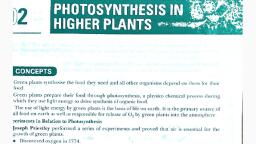Page 2 :
(d) | Glycolysis, , It is the process in which one molecule, , | of gluease Is bwoken down into two, , molecules of pyruvic acid,, Te occurs in the cytoplasm,, It occurs in both aerobic and anacrobie, conditions, It results in the net gain of of 2 ATP, and 2 NADH ® (total of 8 ATP) per, molecule of glucose., , , , , , ~~ Aerobic Respiration, , ! broken down into carbon dioxide and water,, , | — There is a net gain of thirty six molecules, of ATP for every molecule of glucose., , | - NADH is oxidised on the electron transport, chain and the reaction is very vigorous., , , , | ~ Itisa process in which glucose is completely, , , , Rogpiration in Plants 67, , Clirte Acid Cycle, Wis the process in whieh pyruvic, acid is complotely oxidised (o carbon, dioxide and water, Ue ovcurs in the mitoschondrial matrix,, IL occurs only when suflicient oxygen, is available (aerobic), It results in the formation of 2 GTP,, 6 NADIT and 2 FAD, (total of 24 ATP), per molecule of glucose,, , , , mentation, , , , process in which glucose is, only partially oxidised to some organic, compound and carbon dioxide., , — There is a net gain of only wvo molecules, of ATP per molecule of glucose., , — NADH is used tor a reduction step or, slowly oxidised to NAD‘., , , , , , , , Ans. Refer to Fig. 14.1 in the text., , leaving three molecules of carbon dioxid, ~ It takes place in the matrix of the mitoch, , with simultaneous synthesis of ATP., Aerobic respiration takes place in the matri, , 14.8,, , Ans. Refer to Fig. 14.3 in the text., 14.6. Explain ETS,, , - Electron Transport System (ETS), , , , Of mitochondria., , 14.2. What are respiratory substrates? Name the most common respiratory substrate., , Ans. — Respiratory substrates are those organic compounds, which are oxidised to yield energy., — Glucose is the most common respiratory substrate., , 14.3. Give the schematic representation of glycolysis., , i4.4, What are the main steps in aerobic respiration? Where does it take place?, Ans, (i) ~ The complete oxidation of pyruvate by the stepwise removal of all the hydrogen atoms,, , le., hondria., , (a) The passage of the electrons removed as part of the hydrogen atoms to molecular oxygen,, , x and inner membrane of mitochondria,, , Give the schematic representation of an overall view of Krebs’ cycle., , ~ ETS occurs in the electron transport particles (ETP) on the inner surface of the inner membrane, , ~ NADH formed in glycolysis and citric acid cycle are oxidised by NADH-dehydrogenase, , (complex I) and the electrons are transferred to u, , biquinone, via Flavin mononucleotide (FMN).
Page 3 :
68 Paoerker wuts Biolopy—I1 r, , Ubiquinone also receives reducing equivalents via Flavin adenine dinucleos;, (PADI )generated during the oxidation of succinate by succinate dehydrogenase © req, The reduced ubiquinone, called ubiquinol, is then oxidised by transfer of electrons , “on Ploy, ©, Wa cytochrome be,-complex (complex IIT). S10 cyt,, Cytochrome c acts as a mobile carrier between complex IIL and complex Ty., , ~ Complex IV refers to cytochrome ¢ oxidase complex containing cytochromes aa, two copper centres, ni 4 ang, When the electrons are shunted over the carriers via complex I to IV in the electron, chain, they are coupled to ATP synthetase (complex V) for the formation of ATP nn Spor, and iP. om ADp, , inguish between the following:, , (a) Aerobic respiration and Anaerobic respiration, , (b) Glycolysis and Fermentation, , (c) Glycolysis and Citric acid Cycle, , , , Ans. @ Fo Aerobic Respiration = Anaerobic Respiration, i— It is the type of respi-ration that occurs |— It is the type of respiration, ‘that occurs, i in the presence of molecular oxygen. in the absence of molecular oxygen,, _— The respiratory substrate is completely |— The respiratory substrate is only partially, oxidised. oxidised. 7, 1— The reactions take place in the cytoplasm | — The reactions take place in the cytoplasm, and mitochondria. only. |, _— Carbon dioxide, water and energy are the | ~ Ethyl alcohol or organic acids (lactic acid),, end products. | CO, and energy are the end products. |, | Energy is liberated in large quantity. - Energy is liberated in less quantity. |, (6) J —_ Glycolysis cape Fermentation — |, , i= It is the process in which one molecule | — It is the process in which pyruvic acid is, of glucose is broken down into two | converted by certain microbes into alcohol, molecules of pyruvic acid. | or organic acid., , — Oxygen does not influence its reaction. |— It occurs only in the absence of oxyge!., , , , (c) Refer to Ans, 14.1 (6), , -4\g, What are the assumptions made for the calculation of net gain of ATP? . i, Ans. (© There is a sequential, orderly pathway: glycolysis, TCA cycle and ETS, following one, afier the other. ssl, , (ii) The NADH synthesised in glycolysis is transported into the mitochondria, where it undergoes, |, , oxidation., (iii) None of the intermediates is utilised to synthesise any other compound., (iv) Only glucose forms the respiratory substrate and no other substrate enters the pathway «, any of the intermediary stages.
Page 4 :
ABS., , Discuss *The respiratory pathway is an, , amphibolic pathway’., , Respiration involves breakdown of, , respiratory substrates; the compounds, , formed as a result of breakdown enter, different pathways for synthesis of, yarious compounds., , Fatty acids are broken down to acetyl, , CoA before entering the respiratory, , pathway, when they are the respiratory, , substrates., , But when the organism requires to, , synthesize fatty acids, acetyl CoA, , would be withdrawn from the respiratory, pathway., , When proteins are the respiratory, , substrates, amino acids are deaminated, , to form pyruvic acid which enters the, respiratory pathway., , — Pyruvic acid from respiratory pathway, is the raw material for the manufacture, of amino acids., , — Since respiratory pathway involves, anabolism as well as catabolism, it is, known as amphibolic pathway., , SOLVED QUESTION BANK, , Very Short Answer Type Questions [1 Mark], , |. Where do the living organisms obtain the, , An, , 8,, , energy from, for all the life processes?, , Living organisms obtain energy by the, oxidation of macromolecules that are, consumed as food., , » Why is respiration necessary?, Ans,, , Respiration is necessary because it is, the mechanism of oxidation of food/, macromolecules to release energy for all, life processes., , SR z, , 14.10., AWS., , W414., Ags., , 44.12., , ARS., , 3., , Ans:, , Ans:, , Respiration in Plants 69, , Define RQ. What is its value for fats?, Respiratory quotient is defined as the ratio, of the volume of carbon dioxide evolved, to the volume of oxygen consumed in, respiration., , ~ RQ for fats is 0.7., , What is oxidative phosphorylation?, , Oxidative phosphorylation refers to the, , formation of ATP in the mitochondria,, , utilising the energy obtained by the oxidation, of organic molecules., , What is the significance of step-wise, , release of energy in respiration?, , (i) Astepwise release of energy facilitates, the utilisation of a relatively higher, proportion of that energy in the, synthesis of ATP., , (ii) This provides a mechanism to control., the rate of the pathway and the energy, output according to the need of the, cell because activities of enzymes for, the different steps can be enhance:d or, inhibited by specific compounds., , (iii) The same pathway may be utilised, , for forming intermediates used in the, synthesis of other biomolecules., , Why should food be translocated from, the leaves to roots and other non-green, parts of the plants?, , — Non-green parts of plants require food, for oxidation to obtain energy., , — Food is prepared only if green parts, containing chlorophyll; hence, food has, to be translocated from green parts of, the plants to non-green parts., , : Define cellular respiration., , It is the process of breaking of the C-C, bonds of complex organic compounds, through oxidation within the cell to release, considerable amount of energy.
Page 5 :
70, , 5, , Ans., , Ans., , Ans,, , Ans., , Ans., , 10., Ans., I., , Ans., , Ans., 13., , Ans., 14,, , Ans., , , , Fegether eth® Biology—Il, , . Why is respiration called cellular, , respiration?, , — Respiration, i.e. oxidation of food, molecules to liberate energy oceurs 10, the cytoplasm and mitochondria of cells:, hence, it is called cellular respiration., , . Name the energy currency of living cells., , Adenosine triphosphate (ATP), , . When an organic compound is oxidised in, , respiration, energy is used to synthesise, ATP. What happens to the carbon skeleton, produced during respiration?, , The carbon skeleton produced during, respiration is used as precursors for, biosynthesis of other organic compounds., , . Write the equation for respiration of, , glucose., C,H,,0, + 60,—> 6CO, + 6H,O + energy, , Iz, , . Name the two types of anaerobes., , Facultative anaerobes and obligate, anaerobes., , Where is glucose derived from, in plants?, From sucrose or starch., , What is the function of invertase in, plants?, , Invertase catalyses the conversion of sucrose, into glucose and fructose., , . Name the two monosaccharides that, , readily enter the glycolytic pathway., Glucose and fructose., , Name the enzyme that catalyses the, phosphorylation of glucose., , Hexokinase., , What are the products formed by the, splitting of fructose 1,6 bisphosphate?, , 3-phosphoglyceraldehyde and dihydroxyacetone phosphate., , , , 15., , Ans., , 16., , Ans,, , Ans., , 18,, , Ans., 1., , Ans., , 20., , Ans., a., , Ans., , 22., , Ans., , . Write the reaction in SAycotysig, wy, , i, , , , Write the step in Bventysis, ”, , + Ef are formed. How mee, of NADK are formed dois, Mey,, of one molecule of afucnse> Berrien, , 4, , - When 3-phosphoztycer, het,, converted into I, 3 bis oui, , ; : Spin:, acid. ”, , , , , , Vers, , — Two molecules of NADEP Se fy, Expand BPGA- vel, Bisphosphoglyceric acid., , fiers, , one molecule of water is Femoved' f,, oe EOE, , the substrate., , 2-Phosphoglycerate — PRosphoena), , pyruvate. :, , Can you calculate how many Moferates, , of ATP are directly synthesised jn this, , pathway (glycolysis) from one Molecule, , of glucose? (In-text), , Four molecules of ATP, , Pyruvic acid, the key/end product of, , glycolysis has many metabolic fates. Whar, , does it form under aerobic condition?, , {t forms carbon dioxide and water, with the, , release of energy., , How many molecules of ATP are consumed, , during glycolysis of one molecule of, , glucose?, , Two molecules of ATP., , Name two instances where Jactie acid is, , formed by fermentation., , — During fermentation by lactic aci¢, bacteria., , - During strenuous exercise, in the striated, muscles in humans,, , What percentage of energy from a, , glucose molecule is liberated during, , fermentation?, , Less than seven per cent.
































































